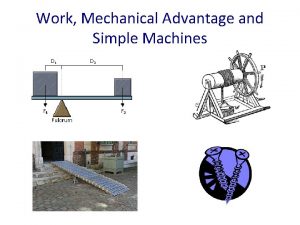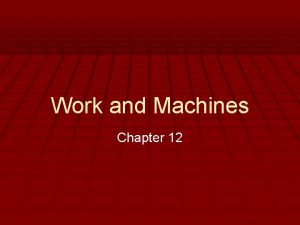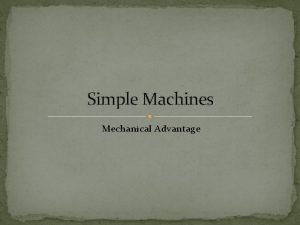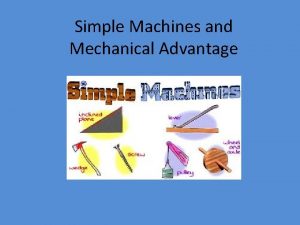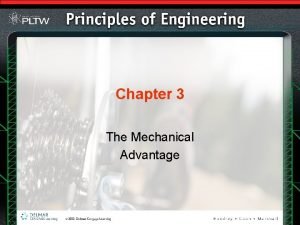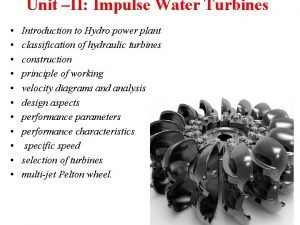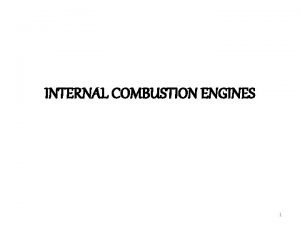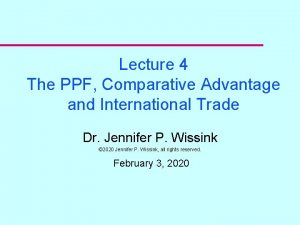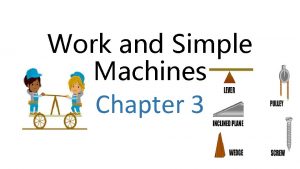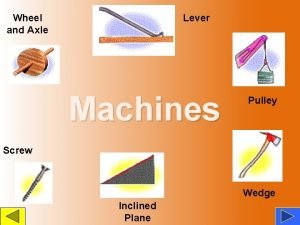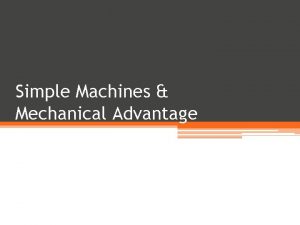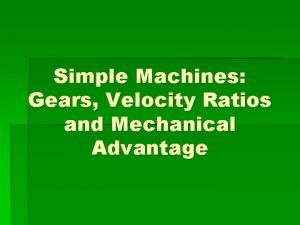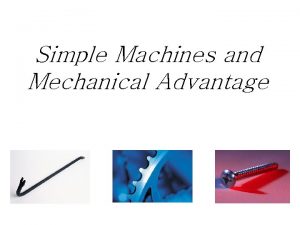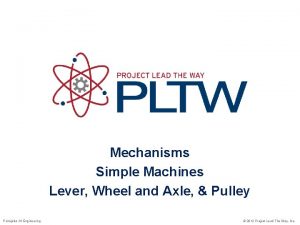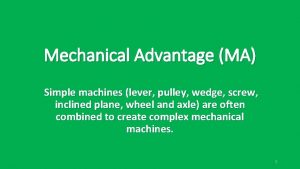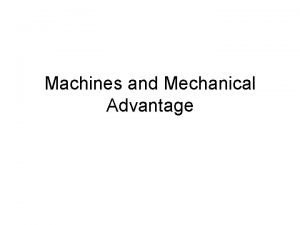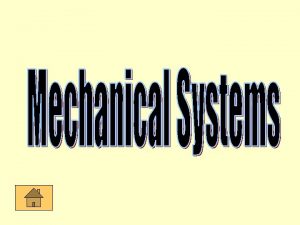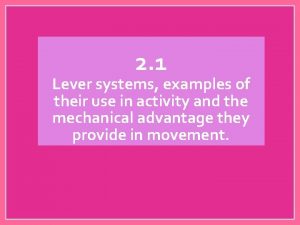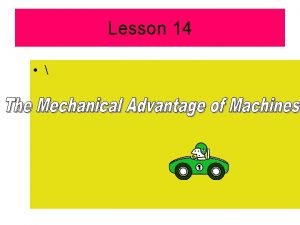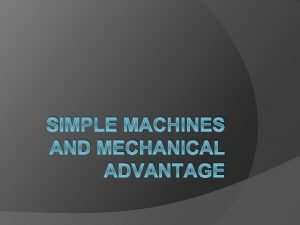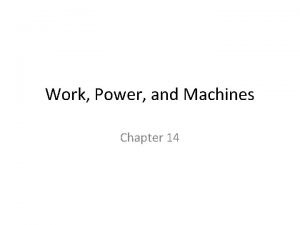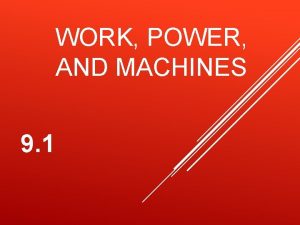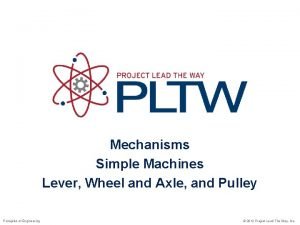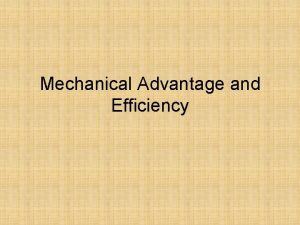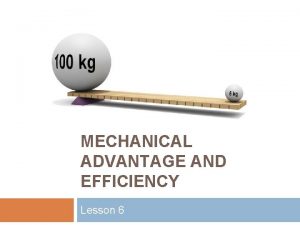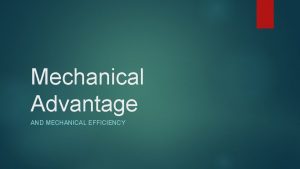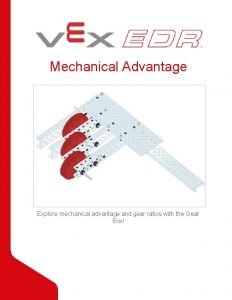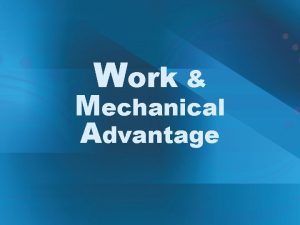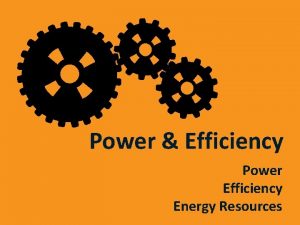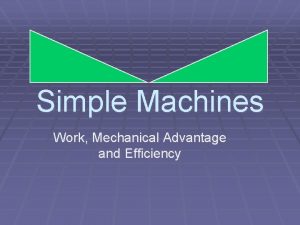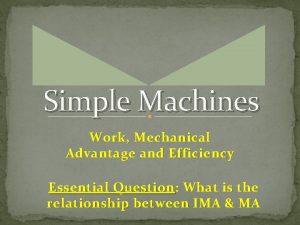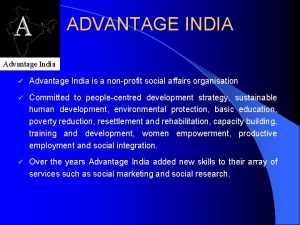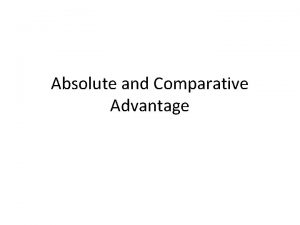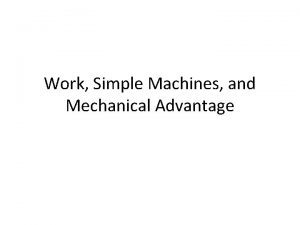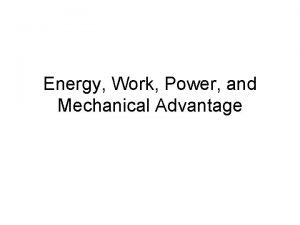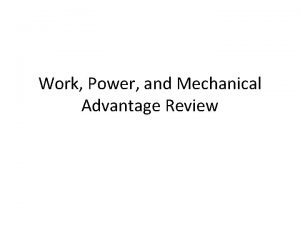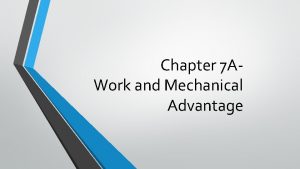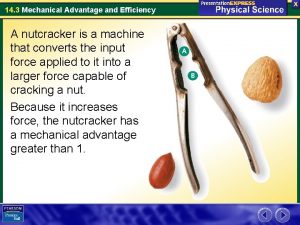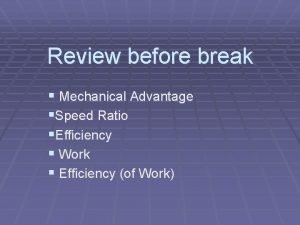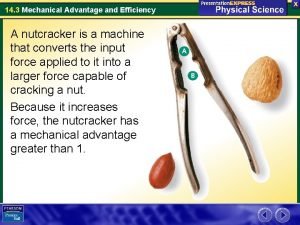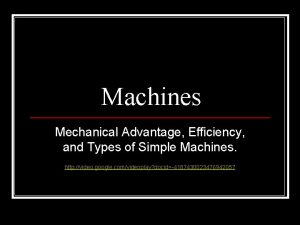Work Power Mechanical Advantage Efficiency C 14 S
































- Slides: 32

Work, Power, Mechanical Advantage, & Efficiency (C 14, S 1 & S 2) 1

What is work? In science, the word work has a different meaning than you may be familiar with. Work: using a force to move an object a distance 2

Doing work • To do work, an object must move in the direction a force is applied. • The boy’s arms do work when they exert an upward force on the basket and the basket moves upward.

Doing NO work • The boy’s arms still exert an upward force on the basket. • But when the boy walks forward, the MOTION and FORCE are in different directions, so NO work is done.

Work or Not? According to the scientific definition, what is work and what is not? 1. a teacher lecturing to her class? ? 2. a mouse pushing a piece of cheese with its nose across the floor? ? 5

Yes, this is work! 6

Is it work? A body builder lifts 350 pounds above his head? ? YES! A mother carries her baby from room to room? ? NO! A father pushes a baby in a carriage? ? YES! A woman carries a 20 kg grocery bag to her car? ? NO! A scientist delivers a speech to an audience of his peers? ? NO! 7

Calculating work • “Distance” is while the force is being applied. • The SI unit for work is the joule (j), named for the nineteenth-century scientist James Prescott Joule.

Calculating work, continued w=f d • Coach Miller lifted a box with a force of 50 N. He lifted the box 2 m. How much work did he do? w = ? f = 50 N d = 2 m w = fd = 50 2 = 100 j

Calculating work, continued w=f d • Coach Grosz lifted an injured student with a force of 100 N. She lifted the person 1. 5 m. How much work did she do? w= ? f = 100 N d = 1. 5 m w = fd = 100 1. 5 = 150 j

Calculating work, continued w=f d • Ms. Vickers needs to get a 1, 000 kg box into the back of a truck. This will take 1, 500 j of work over a distance of 5 m when using an inclined plane. With how much force must she push the box to get it up the inclined plane? w = 1500 j 1500 = f 5 f= ? 1500 = f 5 5 5 d= 5 m f = 300 N

Work - using an inclined plane

History of Work Before engines and motors were invented, people had to do things like lifting or pushing heavy loads by hand. Using an animal could help, but what they really needed were some clever ways to either make work easier or faster. 13

What is Power? • What does it mean to be powerful? Imagine two weightlifters lifting the same amount of weight the same height. • They both do the same amount of work. However, the amount of power they use depends on how long it took to do the work.

What is Power? • Power is how quickly work is done; It is the rate, or speed, at which energy is transferred. • The weightlifter who lifted the weight in less time is more powerful.

Calculating Power • The SI unit of power is the watt, in honor of James Watt, a nineteenth-century British scientist, who invented a practical version of the steam engine.

Calculating Power, continued p = w/t • Ms. Dixon does 140 j of work in 20 s. How much power in watts did she use? p= ? w = 140 j t = 20 s p = w/t = 140 / 20 = 7 watts

Calculating Power, continued p = w/t • Mr. Travis does 210 j of work in 70 s. How much power in watts did he use? p= ? w = 210 j p = w/t = 70 s 210 / 70 = 3 watts

Calculating Power, continued p = w/t • Ms. Watson uses 20 watts of power to push a student across the room in a rolley chair. If she pushes the student for 4 s, how much work has she done? p = 20 wattsw = p = w/t ? 20 = w/4 4 20 = w t= 4 s W = 80 j

ADVANCED Calculations w = fd p = w/t • Dr. Mathis pushes a desk 10 m using 25 N of force and it takes her 5 seconds. How much power did she use? w=? f = 25 N d = 10 m w = f d 25 10 = 250 j p= ? w = 250 ? j t= 5 s p = w/t = 250 / 5 = 50 watts

ADVANCED Calculations w = fd p = w/t • Ms. Miller pulls a box of paper 20 m using 50 N of force and it takes her 10 seconds. How much power did she use? w=? f = 50 N d = 20 m w = f d 50 20 = 1000 j p= ? w = 1000 j t = 10 s ? p = w/t = 1000/ 10 = 100 watts

Question 1 When a force causes motion to occur in the same direction in which the force has been applied, we say that _______ has been done. Answer 1 Work is done when an object moves in the same direction a force is applied.

Question 2 Suppose you are waiting for a train. While you are standing on the platform, your arms are becoming more and more tired from holding your heavy suitcases. Are you doing work? Answer 2 NO, when you lifted the suitcases you were doing work because you applied a force and moved an object. Holding the bags, although tiring, is NOT considered work.

Question 3 In SI, the unit for work is the _______. A. Ampere B. Joule C. Newton D. Watt Answer 3 The correct answer is B. The SI unit for work is the joule.

Question 4 In SI, the unit for power is the _______. A. Ampere B. Joule C. Newton D. Watt Answer 4 The correct answer is D. The SI unit for power is the watt.

Mechanical Advantage • What is the advantage of using a machine? • Machines make work easier (less force) OR shorter (less distance) but it cannot do both at the same time! • A machine changes the way in which you do work but the total AMOUNT of work is the SAME

Mechanical Advantage • The force that you apply on a machine is the input force. • The force the machine applies is output force.

Mechanical Advantage • The number of times a machine increases the input force is the mechanical advantage of the machine. • The greater the M. A. , the easier the work.

Efficiency and Friction • Efficiency is a measure of a machine’s effectiveness (a. k. a. ratio of the output work to the input work). • Friction is always present between moving parts of a machine • Friction reduces the efficiency of machines by converting some of the input work into heat

Efficiency and Friction • To reduce friction between two surfaces, add oil or other lubricants. • Oil fills the gaps between the surfaces, and keeps many of the high spots from making contact. • Lubricants allow MORE input work to be converted to output work which makes the machine MORE efficient!

Question 5 The force that you apply on a machine is known as the _______. Answer 5 The force that you apply is the input force. The force the machine applies is the output force.

Question 6 There are three main advantages to using a machine. In what three ways does a machine make work easier? Answer 6 A machine makes work easier by changing the amount of force you need to exert, changing the distance over which the force is exerted, and changing the direction in which you exert the force.
 Actual mechanical advantage vs ideal mechanical advantage
Actual mechanical advantage vs ideal mechanical advantage Mechanical advantage vs efficiency
Mechanical advantage vs efficiency How does mechanical advantage work
How does mechanical advantage work Section 1 work and machines answer key
Section 1 work and machines answer key The ratio of resistance force to effort force
The ratio of resistance force to effort force Benefits of simple machines
Benefits of simple machines Ideal mechanical advantage definition
Ideal mechanical advantage definition Work power and efficiency
Work power and efficiency Opportunity cost formula
Opportunity cost formula Productively efficient vs allocatively efficient
Productively efficient vs allocatively efficient Productively efficient vs allocatively efficient
Productively efficient vs allocatively efficient Mechanical efficiency meaning
Mechanical efficiency meaning Efficiency of pelton turbine
Efficiency of pelton turbine Brake power calculation
Brake power calculation Brake power formula
Brake power formula Draw power triangle
Draw power triangle Ppf
Ppf Two wheels of different sizes that rotate together
Two wheels of different sizes that rotate together Wedge wheel and axle
Wedge wheel and axle Ma 6
Ma 6 Velocity ratio for gears
Velocity ratio for gears How to calculate mechanical advantage
How to calculate mechanical advantage 1st class pulley
1st class pulley Pulley lever wedge
Pulley lever wedge Mechanical advantage
Mechanical advantage Wheel and axle mechanical advantage formula
Wheel and axle mechanical advantage formula Potential energy
Potential energy Third class lever sporting examples
Third class lever sporting examples Difference between ideal and actual mechanical advantage
Difference between ideal and actual mechanical advantage Actual mechanical advantage definition
Actual mechanical advantage definition Mechanical advantage triangle
Mechanical advantage triangle Mechanical advantage
Mechanical advantage Ama of lever
Ama of lever


